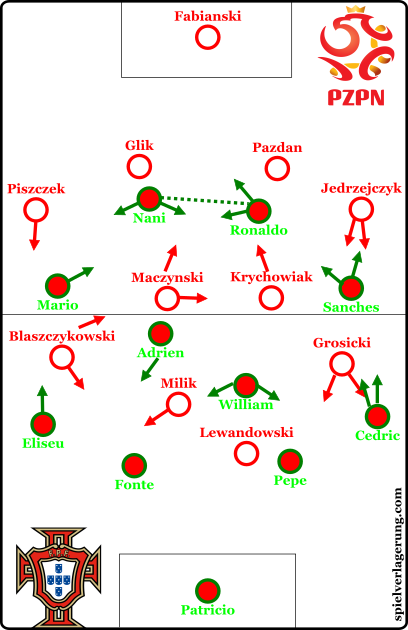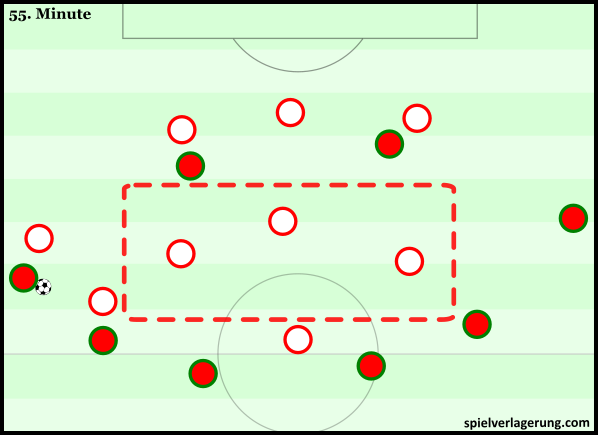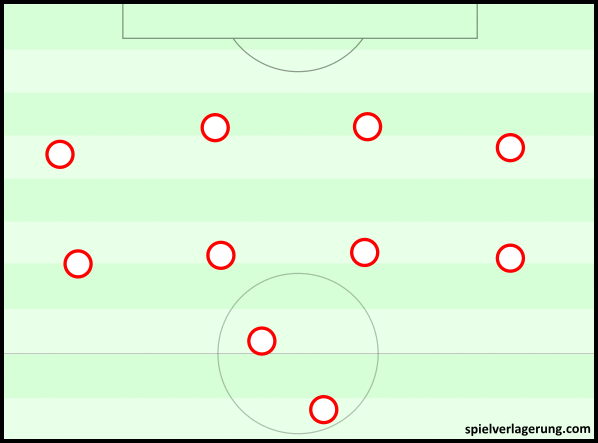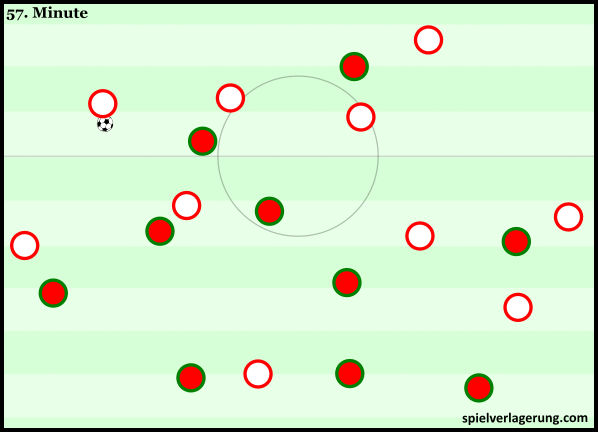Portugal advance despite woeful structuring
The quarter finals of this year’s European Championship kicked off as Portugal faced Poland in Marseille on Thursday evening. Both sides arrived at the game unbeaten in the tournament so far, however Portugal had not won a single game in normal time yet and Poland had only won their opening game in that time period. What followed was a display somewhat typical of both teams’ performances in the competition thus far.
Poland’s kick off strategy 
As a somewhat indirect result of their strategy from kick-off Poland found themselves a goal up within 2 minutes. From the kick off Krychowiak played a long ball towards Jedrzejczyk which was overhit and went out for a throw deep in Portugal’s half. Quite naturally from a throw-in Poland occupied highly ball-oriented positions and they used this to provide constant access in their pressing as they aimed to prevent Portugal from advancing out of their half cleanly.
Even long balls that were not initially accurate were chased down as this assisted with forcing hasty clearances and other sub optimal actions which would allow Poland to sustain pressure on the opposing defence. This is exactly what led to the opening goal, under pressure from a throw in Pepe made a wild clearance that was simply launched back into Portugal’s half. After a gross misjudgement by Cedric, Grosicki sped away to cut the ball back for Lewandowsi to finish first time.
Portugal’s incoherent attack
Once again Portugal showed no coherent plan or strategy for how to attack, the issues were two fold and inter-related. From observing Portugal it is clear to see that either his instructions lead to poor positional occupation in possession or he has not been attempted to implement a framework for their possession game. With no framework the responsibility is thrown over to the players who are given freedom in terms of their positioning and actions on the ball.
This would not be so much of a problem for a squad with strong synergy between player profiles and crucially enough strategy focused players, as they could be trusted to form appropriate structures. However with some of the player profiles in this team, the forwards in particular, this approach was bound to create issues. The egotistical nature of the forward pair of Nani and Ronaldo meant they would often move into areas with the sole intention of getting on the ball with little or no regard for the adverse impacts it had on their structure.
Furthermore their limited strategic nous meant that even if they tried to act in a way to serve the team they were not often able to do so effectively. Over the course of the game they could often be found moving both towards the ball and into another team-mates’ space thus bringing additional Poland defenders across to the ball and making it more difficult for the Portuguese midfielders to create with the possession they had.
These issues were not solely limited to the forwards though. The midfielders struggled to stagger themselves effectively to create as many passing options as possible for the ball carrier. This meant the structures were often very flat as they tended to occupy similar lines. Furthermore by being positioned at such angles from one another they effectively reduced the range of actions their team-mates had available. This had the effect of making them more predictable and thus easier to defend against.
In typical fashion Portugal’s poor structuring made them somewhat vulnerable in defensive transitions. In this case it was manifested in a slightly different format. Poland’s offensive transitions were somewhat direct with the aim of playing quickly into one of the front 3 at times even including long balls. Whilst the likes of Pepe and and Fonte generally fared well against these in preventing the forwards from turning and attacking, at times even forcing the ball backwards. The distances between the sub-units of their team meant the line of midfield were often still some way from recovering their positions and Poland could simply create the next wave of attack.
It was in these 2nd phases of Poland’s counters that Santos’ men struggled to prevent their opponents from advancing. The defenders often did well to reduce the threat of these situations by dropping back and encouraging Milik, Lewandowski and Grosicki to attempt shots and crosses from further out. In these moments Poland could be accused of lacking the patience to provoke the situation and create more danger. Milik and Grosicki in particular were at fault for distance shooting and crossing through a lack of either patience or nous.
With no strategy or plan for how to attack Portugal were once again reliant on the class of their individuals to create chances as opposed to giving them the best possible platform for them to utilise their abilities. As so often for teams without an offensive plan, aimless crosses were the next resort. There were a number of issues behind these crosses that led to them having no effect, asides from the usual inefficiency of crossing anyway.
Firstly they were often swung in from poor locations. As Portugal lacked the ability to create structural advantages that would allow them to advance into dangerous positions they frequently became frustrated and resorted to crossing from deep and wide positions. Furthermore these crosses were not often prepared well, which led to two more issues. One of which was a lack of presence in the box. On many occasions crosses were swung in with only Ronaldo in the box, he was thus heavily outnumbered and Poland found it easy to deal with the crosses. Another result of unprepared crosses was the actual execution, a number of crosses were swung in far too high or deep for anyone to realistically make contact with.
Poland’s offensive game plan
Upon gaining possession Poland would rotate into a 3-4-3 shape via a few different simple movements. They would often begin their build-up in very deep positions, just outside their penalty area. The distances between their lines of defence, midfield and attack was often unsuitably large but it seemingly hinted at a general strategy.
By beginning their build-up in such deep positions they may have been aiming to exploit the tendency of Portugal’s midfielders to vacate their positions. With large distances between players they, intentionally or otherwise, reduced not only their connections but the defensive connections that Portugal could benefit from.
Just as Poland had seemingly prepared for, Portugal’s midfielders frequently moved into the front line when acting against Poland’s first phase of build-up. They would form a situational diamond shape with either Sanches or Adrien joining Ronaldo in the front line and the other staying slightly deeper and maintaining access to Poland’s deepest midfielder.
Once Portugal’s midfielders had been drawn out to a satisfactory level they sought to play directly into the forwards, Lewandowski, Milik and Grosicki. On several occasions Portugal’s defence found this fairly simple to deal with and cleared the ball instantly but due to the midfielders being drawn out and attempting to recover their positions, the ball would often fall for Poland’s midfielders or attackers to attack again. It was these situations Poland seemingly benefitted from the most, due to the almost constant absence of Portugal’s midfield the receiver of 2nd balls were often allowed to assess their options and pick passes free from pressure.
In all phases of their possession game Nawalka’s side displayed a left side focus. Perhaps they saw a potentially advantageous match up with Grosicki against Cedric and thus sought to create as many of these situations as they could. This focus began right from their build-up where they would circulate the ball across the backline to create space for Pazdan to advance with the ball on the left. At times he was seen pushing forwards with the aim of putting Nani in a difficult situation where he had to leave his man to prevent the ball carrier from progressing. Once this was done a small number of simple combinations would get the ball into Grosicki.
Whilst Grosicki often had the beating of Cedric he was typically erratic with his decision making and execution of actions. The situation for the opening goal where he intelligently found a cut back was all too rare.
2nd half
The second half continued in much the same manner as the 1st with only a couple of minor adjustments from Poland which were perhaps even improvised by the players.
For much of the 2nd half particularly towards the end Poland could be seen finding it gradually easier and easier to progress into midfield and attack, and there were two main reasons behind this. One was the slightly decreased distances between players in build-up. As expected this gave them greater potential avenues to progress gradually as opposed to the long balls they often used particularly early on in the first half. This hinted that the initial long ball strategy may have been intended to move Portugal into deeper positions in defence to give Portugal more space to build-up.
Another reason behind their increased ease in build-up was an interesting dismarking method they used somewhat sporadically. Though this may have hinted it was not a particularly strategic move. On one or two occasions the likes of Milik would drop towards the ball and would initially be followed until a team-mate began moving into the space the Portuguese defender had just vacated. This simple scheme made their opponents drop off and gave them the crucial potential to create a free man.
It is well known that moving across different zones on the pitch is enough to allow one to lose their original marker, however it is likely to mean they pick up a new one. What Poland did however was combine this with a small overload which gave their Portuguese opponents a decision to make. They could either drop and cover the player in more advanced positions thus allowing Poland to progress via the free man. Or mark the deeper opponent thus risking a defensive underload in more hazardous areas. At times Portugal were caught between the two options which allowed Poland to make use of both the free man and the runner in behind.
Extra Time
As so often extra time was characterised by extreme fatigue and the effects were clear to see on proceedings. Small tactical adjustments such as the change in Poland’s structure with Kuba moving out to the flank and Milik moving infield had little or no effect, at least partly for these reasons.
Conclusion
Once again Portugal have managed to progress despite their severe structural flaws. They now find themselves in the semi-finals of the Euro Championship despite having failed to win a single game in normal time during the competition. Without large slices of luck it is hard to see Portugal beating the likes of Germany or Italy but perhaps lady luck will smile on them yet again.
Poland will be disappointed and rightly so. They had a far more coherent game plan than their opponents and executed it to a decent level. However a quarter-final appearance is probably more than they expected and it was their failure to convert several dangerous attacks into high quality shots that ultimately let them down.



Keine Kommentare vorhanden Alle anzeigen